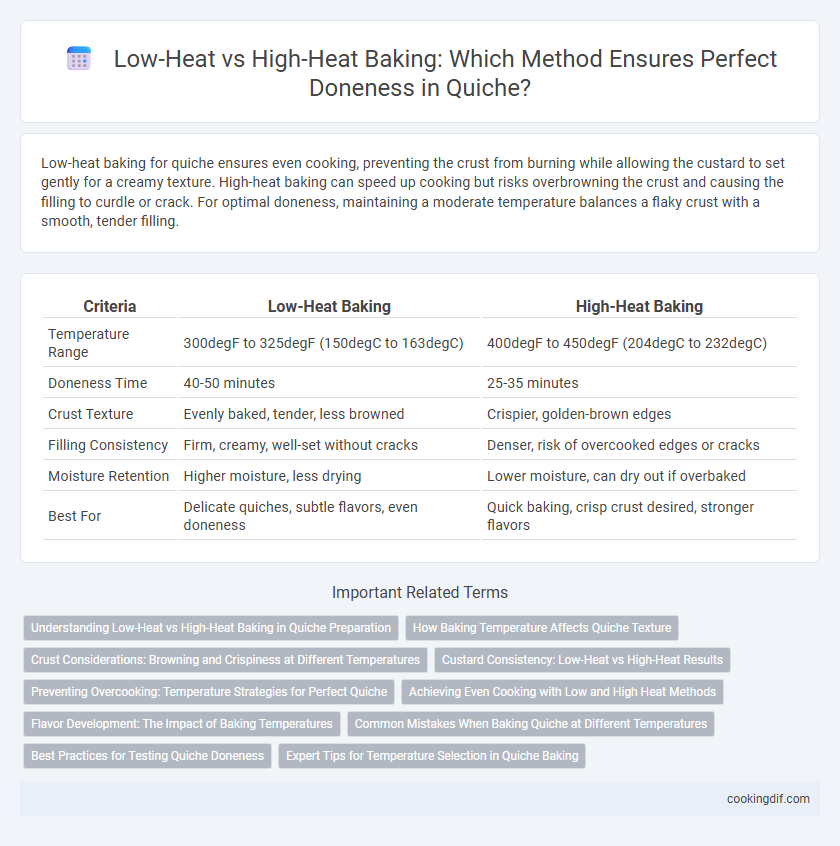Low-heat baking for quiche ensures even cooking, preventing the crust from burning while allowing the custard to set gently for a creamy texture. High-heat baking can speed up cooking but risks overbrowning the crust and causing the filling to curdle or crack. For optimal doneness, maintaining a moderate temperature balances a flaky crust with a smooth, tender filling.
Table of Comparison
| Criteria | Low-Heat Baking | High-Heat Baking |
|---|---|---|
| Temperature Range | 300degF to 325degF (150degC to 163degC) | 400degF to 450degF (204degC to 232degC) |
| Doneness Time | 40-50 minutes | 25-35 minutes |
| Crust Texture | Evenly baked, tender, less browned | Crispier, golden-brown edges |
| Filling Consistency | Firm, creamy, well-set without cracks | Denser, risk of overcooked edges or cracks |
| Moisture Retention | Higher moisture, less drying | Lower moisture, can dry out if overbaked |
| Best For | Delicate quiches, subtle flavors, even doneness | Quick baking, crisp crust desired, stronger flavors |
Understanding Low-Heat vs High-Heat Baking in Quiche Preparation
Low-heat baking in quiche preparation ensures even cooking and prevents the custard from curdling, resulting in a smooth, creamy texture. High-heat baking promotes a golden, flaky crust but risks overcooking the filling, causing a rubbery consistency. Balancing moderate temperatures around 325degF to 350degF optimizes doneness by achieving a tender filling and a crisp, well-browned crust.
How Baking Temperature Affects Quiche Texture
Baking quiche at low heat ensures a smooth, custard-like texture by allowing the eggs and cream to set gradually without curdling or cracking. High-heat baking can cause the quiche filling to become rubbery and the crust to brown too quickly, often resulting in uneven doneness. Optimal temperatures around 325degF to 350degF promote even cooking, preserving a creamy interior and a flaky, golden crust.
Crust Considerations: Browning and Crispiness at Different Temperatures
Low-heat baking at temperatures around 325degF ensures a gentle cook that produces an evenly browned, tender quiche crust without risk of burning but may result in less crispiness. High-heat baking at 400degF to 425degF promotes rapid caramelization, yielding a golden, crispy crust with pronounced browning, though it requires careful monitoring to prevent overbrowning or burning. Optimal crust texture often balances initial high-heat baking for browning followed by reduced heat to cook the filling thoroughly while maintaining crispness.
Custard Consistency: Low-Heat vs High-Heat Results
Low-heat baking in quiche ensures a smooth custard consistency by gently coagulating the eggs, preventing curdling and achieving even texture throughout. High-heat baking causes rapid protein coagulation, leading to a rubbery, uneven custard with potential browning on top before the center is fully set. For ideal custard doneness, maintaining a moderate, steady temperature between 325degF and 350degF optimizes the balance between thorough cooking and creamy texture.
Preventing Overcooking: Temperature Strategies for Perfect Quiche
Low-heat baking at 325degF (163degC) ensures even cooking and prevents the quiche from curdling or becoming rubbery, preserving a creamy texture. High-heat baking at 400degF (204degC) risks overcooking the eggs and drying out the custard, resulting in cracks and a tough crust. Optimal temperature control balances heat to set the filling gently while achieving a golden, flaky pastry.
Achieving Even Cooking with Low and High Heat Methods
Low-heat baking at around 325degF (163degC) ensures even cooking by allowing the quiche custard to set slowly without overbrowning the crust, resulting in a tender, creamy texture. High-heat baking, typically above 400degF (204degC), promotes rapid crust browning but risks uneven cooking, often causing the custard to remain undercooked or curdled in areas. Achieving perfect doneness balances heat and time, with low-heat methods favored for consistent texture and high-heat techniques for a crisper crust, often optimized by adjusting baking duration and using insulated pie weights or foil shields.
Flavor Development: The Impact of Baking Temperatures
Baking quiche at low heat enhances flavor complexity by allowing gradual caramelization and Maillard reactions, preserving delicate custard texture while intensifying savory notes. High-heat baking rapidly sets the filling and creates a crisp crust but risks curdling the custard and producing uneven flavor development. Optimal quiche baking balances heat application to maximize flavor depth without compromising texture or doneness.
Common Mistakes When Baking Quiche at Different Temperatures
Baking quiche at too high a temperature often results in a burnt crust and undercooked filling due to rapid browning and uneven heat distribution. Low-heat baking, while gentler, may cause a soggy crust and insufficiently set custard, leaving the center runny. Common mistakes include not adjusting baking time when switching temperatures and failing to use a blind bake for the crust, which compromises texture and doneness.
Best Practices for Testing Quiche Doneness
Low-heat baking at 325degF allows the quiche filling to set gently, preventing curdling and ensuring a smooth, creamy texture, while high-heat baking at 400degF can cause rapid cooking that leads to a rubbery or cracked surface. Best practices for testing quiche doneness include checking that the center is just set and slightly jiggly without liquid consistency, using a toothpick or thin knife inserted near the center to ensure it comes out clean or with minimal moist residue. Resting the quiche for 10-15 minutes after baking allows residual heat to complete the cooking process, improving texture and making the filling firmer for cleaner slicing.
Expert Tips for Temperature Selection in Quiche Baking
Baking quiche at a low heat of around 325degF (163degC) ensures even cooking and prevents the custard from curdling, resulting in a creamy texture. High-heat baking, typically at 400degF (204degC), can quickly set the crust but risks overbaking the filling, causing cracks or a rubbery consistency. Experts recommend starting at a moderate temperature and finishing at higher heat to achieve a perfectly baked quiche with a golden crust and smooth custard.
Low-heat baking vs high-heat baking for doneness Infographic

 cookingdif.com
cookingdif.com